Montana’s vast forests and open woodlands are home to a surprising variety of brilliantly colored songbirds, including several members of the cardinal family (Cardinalidae). While most people recognize the vivid red Northern Cardinal, Montana also welcomes other rare and seasonal visitors that add even more color to the landscape.
From the year-round beauty of the Northern Cardinal to the migratory charm of the Western and Scarlet Tanagers, these birds stand out against the state’s rugged scenery. Each species brings its own unique characteristics—different songs, behaviors, and habitats—making birdwatching in Montana both rewarding and unpredictable.
In this guide, we’ll explore five fascinating types of cardinals in Montana, complete with pictures and identification tips. You’ll learn how to recognize them by sight and sound, understand their feeding and breeding habits, and discover the best places and times to spot them in the wild.
Different Types of Cardinals Found in Montana
Northern Cardinal (Cardinalis cardinalis)
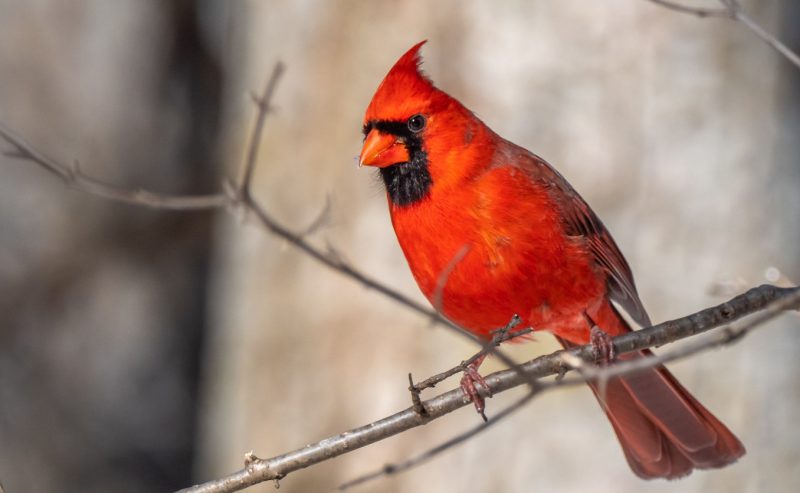
The Northern Cardinal is one of the most easily recognized and admired songbirds in North America. Males are a brilliant shade of crimson red with a black mask surrounding their beak, while females are a warm tan or buff color with subtle red accents on their wings, crest, and tail. Both sexes share a tall, pointed crest and a thick, cone-shaped orange bill designed for cracking seeds. Adults typically measure about 8.3 to 9 inches (21–23 cm) in length, with a wingspan ranging from 9.8 to 12.2 inches (25–31 cm).
In Montana, Northern Cardinals are most commonly observed in the southeastern and central parts of the state, particularly in wooded areas, river valleys, and suburban gardens. Although they are not as widespread as in the eastern United States, their range has gradually expanded westward, aided by bird feeders and suitable habitats. They prefer dense shrubs and thickets that provide both cover and nesting sites.
Northern Cardinals are primarily granivorous but also feed on insects and fruits. During the warmer months, their diet consists of beetles, caterpillars, and other small invertebrates, while in winter, they rely heavily on seeds and berries. They are frequent visitors at backyard feeders, especially those offering sunflower seeds or cracked corn. Their feeding behavior is deliberate and methodical, often perching on low branches or foraging on the ground.
Cardinals are monogamous during the breeding season, which typically runs from March to August in Montana. The female builds a cup-shaped nest using twigs, leaves, and grass, often hidden within dense shrubs. She lays three to four eggs, which she incubates for about two weeks. After hatching, both parents feed the chicks, and the young fledge within 10–12 days. Cardinals can raise two to three broods in a single season if conditions are favorable.
Known for their rich, whistling songs, Northern Cardinals are highly vocal birds that sing throughout the year. Males use their songs to defend territory, while females sing to communicate with mates or signal feeding needs. Their clear, melodious tunes add color and sound to Montana’s landscapes, particularly in wooded parks and rural communities. Even in the cold winters, the flash of red against the snow remains one of the most iconic sights in the state.
Pyrrhuloxia (Cardinalis sinuatus)
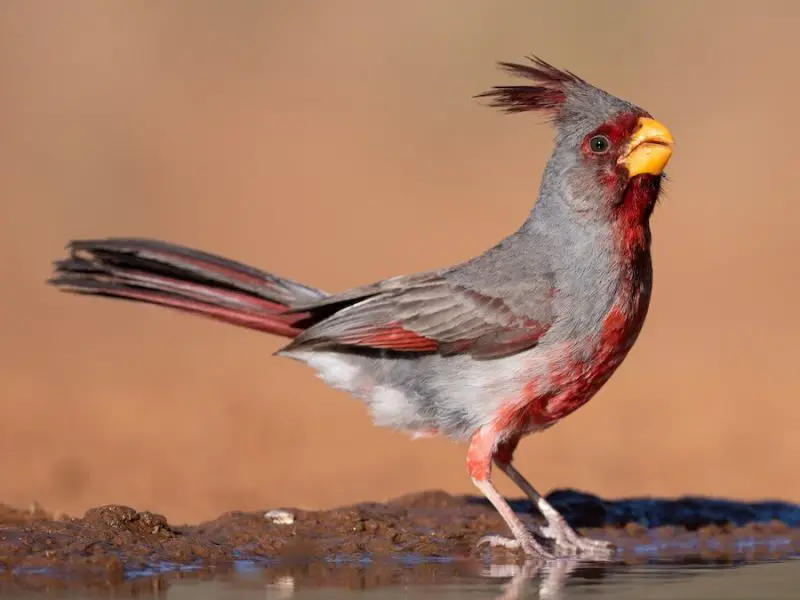
The Pyrrhuloxia, often called the Desert Cardinal, is a striking bird with a unique blend of gray and crimson plumage. Males display bright red on the face, crest, and wings, while females show a more subdued yellowish-gray color with hints of red. Both have a distinctively curved, yellowish bill resembling a parrot’s beak, which helps differentiate them from the Northern Cardinal. Adults are about 8.3 inches (21 cm) long, with a wingspan of approximately 11 inches (28 cm).
Although the Pyrrhuloxia’s range centers in the arid regions of the southwestern United States, it occasionally strays into Montana during warm weather or periods of food scarcity. Sightings are rare, but birders have occasionally reported individuals in the southern and southeastern parts of the state. These birds typically inhabit desert scrublands, mesquite groves, and thorny thickets where they can find both shelter and food sources.
Their diet mainly consists of seeds, grains, and fruits, though they also consume insects during the breeding season. The Pyrrhuloxia’s powerful bill allows it to crack open hard seeds from desert plants and cacti. When foraging, they often move in pairs or small groups, hopping along the ground and flicking their tails. They are known for their resilience and ability to survive in harsh, dry conditions that would challenge many other bird species.
Breeding takes place in spring and early summer, often coinciding with the arrival of rains in their southern range. The female constructs a small cup nest in a shrub or cactus, using grasses, roots, and plant fibers. She lays two to four eggs, incubating them for roughly two weeks. Both parents share feeding duties once the chicks hatch, bringing them insects and small seeds. Despite their desert origins, occasional breeding attempts in Montana have been recorded during warmer years, although they are generally unsuccessful due to the colder climate.
The Pyrrhuloxia’s call is a series of sharp, metallic notes that sound somewhat like a Northern Cardinal’s song but with a flatter, more nasal tone. Their vocalizations help maintain contact within pairs and defend territories. For Montana bird enthusiasts, spotting a Pyrrhuloxia is a rare and special event—a vivid reminder of the unexpected diversity that sometimes graces the state’s skies.
Summer Tanager (Piranga rubra)
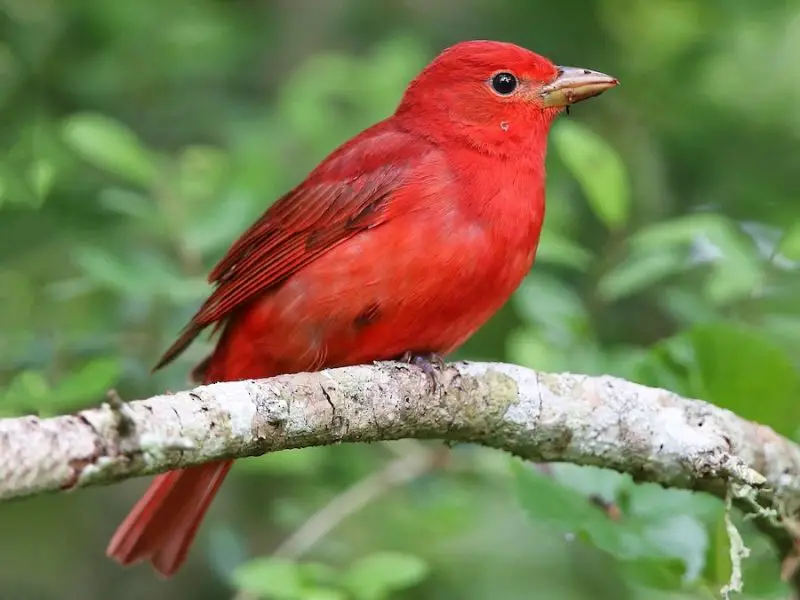
The Summer Tanager is a dazzling bird that belongs to the cardinal family, Cardinalidae, and is renowned for its vibrant coloration. Adult males are completely red from head to tail, while females are a warm yellow-green color, making them easy to distinguish. They are medium-sized songbirds, measuring around 6.7 inches (17 cm) long with a wingspan of approximately 11 inches (28 cm). Their large, pale bill and relatively long tail give them an elegant profile.
In Montana, the Summer Tanager is considered a rare vagrant, typically appearing during spring or fall migration. Most sightings occur in the southeastern regions of the state, especially near riparian corridors, open woodlands, and cottonwood groves. While they do not breed in Montana, their presence during migration adds a touch of tropical brilliance to the local birdwatching scene.
Summer Tanagers primarily feed on insects, with a particular fondness for bees and wasps. They are adept at catching flying insects mid-air, often returning to a perch to beat the prey against a branch before consuming it. Their diet also includes beetles, caterpillars, and various fruits, especially during migration when energy demands are high. They play an important ecological role in controlling insect populations within their range.
During the breeding season in their southern range, Summer Tanagers construct shallow cup-shaped nests on horizontal branches high in trees. The female lays three to four eggs and incubates them for about two weeks. The male assists by bringing food and protecting the nesting area. After hatching, both parents feed the chicks with insects. Though rare in Montana, some individuals may briefly linger in the summer months before continuing north or south depending on seasonal conditions.
The song of the Summer Tanager is a melodic series of phrases resembling that of the American Robin but softer and more fluid. Their call notes include a distinctive “pi-tuk” or “pit-ti-tuk,” often heard before they are seen. For Montana birders, encountering a Summer Tanager is a delightful surprise—a glimpse of the southern woodlands’ color and sound against the rugged beauty of the northern plains.
Scarlet Tanager (Piranga olivacea)
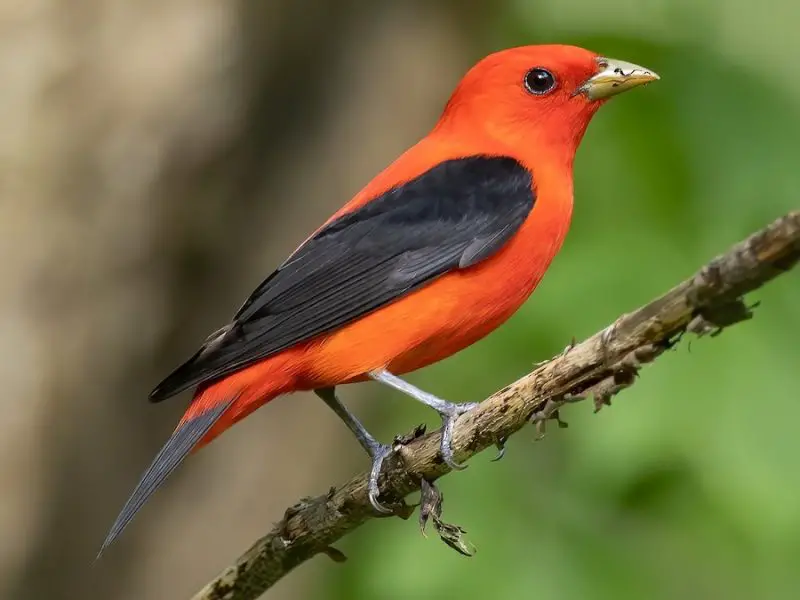
The Scarlet Tanager is one of North America’s most striking forest songbirds, easily recognized by its vivid coloration and contrasting features. Breeding males display a brilliant scarlet-red body with jet-black wings and tail, creating a stunning contrast against green foliage. Females and nonbreeding males, by contrast, are olive-yellow with darker wings, blending seamlessly into the trees. Adult Scarlet Tanagers measure around 6.3 to 7.5 inches (16–19 cm) long and have a wingspan of approximately 9.8 to 11.8 inches (25–30 cm). Their thick, pointed bill is perfect for their mixed diet of insects and fruits.
In Montana, the Scarlet Tanager is considered an uncommon migrant and a rare breeder in the eastern and southeastern woodlands. They favor mature deciduous forests, riparian corridors, and areas with tall oaks and maples where dense canopies provide shelter. While most Scarlet Tanagers breed in the eastern United States, some individuals are spotted in Montana during migration, resting and foraging in wooded habitats before continuing their journey northward or southward.
Scarlet Tanagers are primarily insectivorous during the breeding season, feeding on beetles, caterpillars, ants, and wasps. They forage methodically among leaves and branches, occasionally catching flying insects in midair. In late summer and fall, their diet shifts to include berries and small fruits such as mulberries and dogwood. Their foraging style is slow and deliberate, often making them difficult to spot despite their brilliant coloration.
The breeding season typically occurs between May and July, depending on latitude. The female builds a loose, shallow nest on a horizontal tree branch using grass, twigs, and fine roots. She lays three to five eggs, which she incubates for about two weeks. Males defend territories with sharp “chip-burr” calls and melodic songs, helping ward off rivals. After hatching, both parents feed the chicks insects, and the young fledge after about 9–12 days. In Montana, confirmed nesting records are rare, but some transient pairs may attempt breeding in suitable eastern habitats.
The song of the Scarlet Tanager is a distinctive series of burry, robin-like phrases, described as sounding like “a robin with a sore throat.” Their call note is a sharp “chip-burr,” which is useful for identification even when the bird remains hidden in the canopy. For Montana birders, spotting a Scarlet Tanager is a memorable experience—its fiery plumage set against the state’s green woodlands is a breathtaking contrast that symbolizes the fleeting beauty of spring migration.
Western Tanager (Piranga ludoviciana)
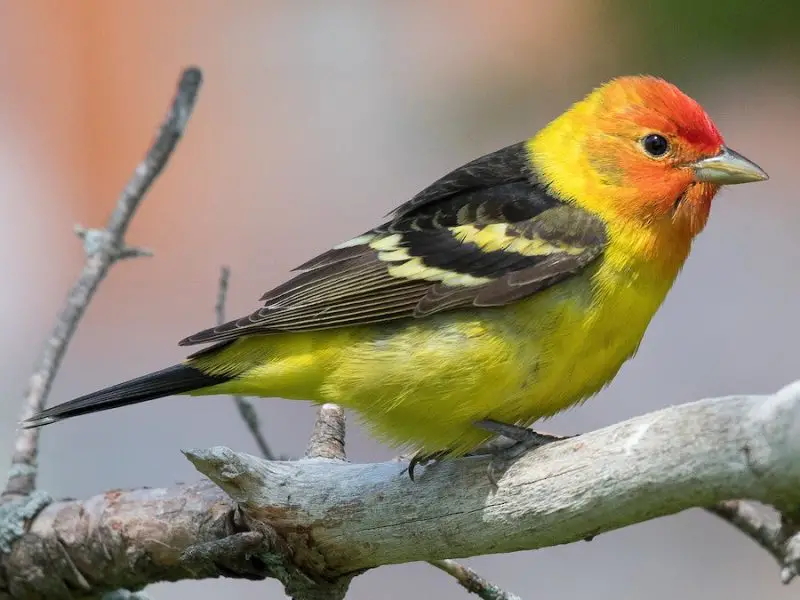
The Western Tanager is one of Montana’s most colorful and widespread summer visitors, belonging to the same cardinal family as the Northern and Scarlet Tanagers. Adult males feature a bright yellow body, a vibrant red-orange head, and contrasting black wings and tail, while females are mostly yellow-green with darker wings. The intensity of the male’s red head comes from pigments called rhodoxanthin, which they acquire from eating specific insects. Adults average 7.3 inches (18.5 cm) in length, with a wingspan of about 11.5 inches (29 cm).
In Montana, Western Tanagers are common breeding birds throughout forested regions, including mountain foothills, pine forests, and mixed coniferous woodlands. They arrive in late spring, typically by May, and remain until early September before migrating south to Mexico and Central America for the winter. Their preferred habitats are open conifer forests, especially areas dominated by ponderosa pine, Douglas fir, and spruce. They can also be found in city parks and wooded suburbs during migration.
Western Tanagers feed primarily on insects, which they glean from foliage or catch in midair. Beetles, ants, wasps, and caterpillars form the bulk of their diet. During late summer, they supplement their food intake with fruits such as serviceberries, chokecherries, and elderberries. They are agile foragers, often seen moving swiftly among branches in search of prey. Their feeding behavior helps control insect populations in forest ecosystems.
During the breeding season, which peaks in June and July, the female builds a shallow, well-camouflaged nest high on a conifer branch. The nest is made of grass, twigs, and bark strips, lined with fine rootlets and hair. She lays three to five bluish-green eggs speckled with brown. Incubation lasts about two weeks, and both parents feed the chicks after hatching. By late summer, young tanagers can be seen following their parents while learning to forage before the southward migration begins.
The Western Tanager’s song consists of short, melodic phrases that sound similar to an American Robin but with a more clipped and less musical tone. Their call note is a distinct “pit-er-ick” or “prit-tic,” often heard as they move through treetops. In Montana’s forests, their vivid colors and cheerful songs are among the most beautiful sights and sounds of summer, signaling the height of the breeding season in the state’s mountainous landscapes.
Best Time and Places to See Cardinals in Montana
Best Time to Observe Cardinals
The best time to observe cardinals in Montana depends on the specific species, but late spring through early fall (May to September) offers the highest chances. During this period, forests and woodlands are alive with color and song as cardinals engage in breeding, feeding, and territorial displays. The Northern Cardinal, Montana’s most consistent resident, can be seen year-round—especially during winter when its crimson plumage stands out vividly against the snow.
For Western Tanagers and Scarlet Tanagers, migration periods are the most rewarding times for birdwatching. Western Tanagers typically arrive in Montana by May and remain until early September, while Scarlet Tanagers are seen primarily during late May to early June as they move through eastern woodlands. The Summer Tanager and Pyrrhuloxia are far rarer visitors, best spotted during warm spells in late spring or early summer when vagrant birds may drift north.
Bird activity peaks early in the morning, especially between 6:00 a.m. and 10:00 a.m., when cardinals are most vocal and active. During the breeding season, males often sing from exposed perches, making them easier to spot. Early morning light also enhances the brilliance of their red and yellow plumage, creating excellent conditions for photography and identification.
Best Places to See Cardinals in Montana
In Montana, wooded river valleys, mixed coniferous forests, and city parks are the best habitats for observing cardinals and tanagers. Northern Cardinals are most frequently seen in southeastern Montana, particularly near Billings, Miles City, and the Yellowstone River corridor, where shrublands and human settlements provide food and nesting cover. They also visit bird feeders offering sunflower seeds or cracked corn.
For Western Tanagers, head to western and central Montana, including the Bitterroot Valley, Helena National Forest, Gallatin Canyon, and Glacier National Park. These areas feature open pine forests and high-elevation woodlands—ideal breeding habitats. Scarlet Tanagers, though rare, can be found in eastern deciduous groves and riparian zones near the Missouri River, especially during migration.
Birdwatchers seeking rarities like the Summer Tanager or Pyrrhuloxia should explore southern Montana along the Yellowstone and Powder River basins, especially during warm summers when these southern visitors occasionally appear. A good pair of binoculars, patience, and an early start are key for successful sightings. Keep a field guide handy to distinguish among the various cardinal family members that brighten Montana’s landscapes.
FAQs About Cardinals in Montana
Are Northern Cardinals common in Montana?
Northern Cardinals are not as widespread in Montana as in the eastern United States, but they are becoming increasingly common in the state’s central and southeastern regions. Bird feeders, suburban landscaping, and mild winters have helped expand their range westward.
Do cardinals stay in Montana year-round?
Yes, Northern Cardinals are year-round residents in parts of Montana, especially in urban and sheltered rural areas. However, species like the Western Tanager and Scarlet Tanager are migratory, visiting only during the warmer months before returning south for winter.
What kind of habitat do cardinals prefer in Montana?
Cardinals prefer dense shrubs, forest edges, and riparian woodlands. Western and Scarlet Tanagers, meanwhile, are more often found in mixed coniferous or deciduous forests. Cardinals thrive in areas that provide both cover for nesting and open spaces for foraging.
How can I attract cardinals to my backyard in Montana?
To attract Northern Cardinals, provide sunflower seeds, safflower seeds, or cracked corn in platform or hopper feeders. Planting native shrubs like dogwood, sumac, or serviceberry also offers natural food and nesting sites. Providing fresh water year-round will make your yard even more inviting.
What time of day is best for spotting cardinals?
Early morning is the best time to observe cardinals, typically between 6 and 10 a.m. when they are most vocal and active. Evening hours, close to sunset, also provide opportunities to see them foraging or returning to roost.
Are there rare cardinal sightings in Montana?
Yes. Rare sightings include the Pyrrhuloxia (Desert Cardinal) and the Summer Tanager, both of which are occasional vagrants from southern regions. While they do not breed in Montana, they have been spotted in southern counties during warm springs or summers.
Do Western Tanagers live in Montana all year?
No, Western Tanagers are seasonal migrants. They breed across Montana’s forests during summer but migrate to Mexico and Central America by early autumn. Their arrival in May is often celebrated by birders across the state.
Why do some cardinals have duller colors?
Female cardinals and immature males tend to have duller plumage for camouflage during nesting and early life stages. Environmental factors such as diet, molting, and sunlight exposure can also affect feather brightness.
Can I see both Western and Scarlet Tanagers in the same area?
In rare cases, yes. During spring migration, both species may pass through eastern and central Montana, though they typically occupy different habitats—Western Tanagers prefer coniferous forests, while Scarlet Tanagers favor deciduous woodlands.
When is the best month to photograph cardinals in Montana?
The best months for photography are May through July, when cardinals and tanagers are in full breeding plumage and highly active. Morning hours provide the best light for capturing their vivid red and yellow hues against Montana’s lush summer greenery.






